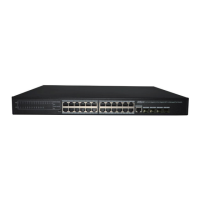
Do you have a question about the Dahua Technology DH-PFS4428-24GT-370 and is the answer not in the manual?
| Ports | 28 |
|---|---|
| Gigabit Ports | 24 |
| Uplink Ports | 4 |
| SFP+ ports quantity | 0 |
| Power over Ethernet (PoE) | Yes |
| Total PoE Power Budget | 370W |
| Switching Capacity | 56 Gbps |
| Layer | 2 |
| Managed | Yes |
| MAC address table | 8K |
| Jumbo frames support | Yes |
| Product colour | Black |
| Mounting | Rack-mountable |
| Form factor | 1U |
| Weight | 3.5 kg |
| Dimensions | 440 x 220 x 44 mm |
| Jumbo frames | 9216 bytes |
| Storage Temperature | -40°C to 70°C |
| Operating Humidity | 10% to 90% (non-condensing) |
| Forwarding Rate | 41.7 Mpps |
Congratulations on your purchasing of the 24-Port Gigabit + 4-Port Gigabit SFP L2 Managed PoE Switch. Before you install and use this product, please read this manual carefully for full exploiting the functions of this product.
Lists key features including IEEE standards compliance, PoE support, MAC address handling, SNMP/RMON/TELENT, VLAN, QoS, ACL, Storm Control, and web-based management.
Details the physical components of the switch, including the front panel (ports, LEDs, reset button) and rear panel (grounding terminal, power connector).
Lists the items included in the switch package for installation, such as the switch, installation components, power cord, and user manual.
Provides general instructions and precautions for safely installing the switch, covering desktop and rack-mountable options.
Guides on connecting a computer via NIC and connecting Powered Devices (PD) to the switch's PoE ports.
Details connecting end nodes to the switch using standard Ethernet cables for network access.
Instructions for accessing the switch's web-based management interface using default IP and credentials.
Provides a quick setup guide for VLANs, ports, and modifying the switch login password.
Covers port settings like basic config, aggregation, mirroring, limits, storm control, isolation, and information retrieval.
Manages VLANs, including VLAN settings, access port, trunk port, and hybrid port configurations.
Includes security and diagnostic features such as Anti Attack, Channel Detection, and Access Control Lists (ACL).
Configures PoE status, power, and priority for individual ports, including chip information.
Configures MSTP region name, revision level, and VLAN mapping for Spanning Tree Protocol.
Configures STP bridge parameters, including mode, priority, hello time, and port settings.
Enables and configures the DHCP relay agent to forward DHCP requests to a server.
Configures DHCP Option 82 for circuit control, proxy remote, and IP address information.
Sets up Quality of Service (QoS) queue scheduling policies and weights for traffic management.
Maps service categories (COS, DSCP) to queues for traffic prioritization and management.
Manages MAC addresses, including adding static MACs, deleting MACs, and viewing the MAC address table.
Configures MAC address learning limits and aging times for the switch.
Filters network traffic based on MAC addresses according to specified conditions.
Enables and configures SNMP functionality, including community, view, group, user, and trap settings.
Configures RMON (Remote Monitoring) for network statistics, including statistics, history, event, and alarm groups.
Configures Link Aggregation Control Protocol (LACP) settings, including enabling LACP and port parameters.
Configures basic system settings like IP, VLAN, device name, time, and restart options.
Manages system software upgrades for the switch.
Manages configuration files through import, export, restore, and factory reset options.
Saves the current switch configuration settings.
Manages user accounts and privileges for system access and maintenance.
Collects system debug information for troubleshooting purposes.
Lists the physical specifications of the switch hardware, including standards, interface, and power.
Details the software features, functional layers, security policies, and application protocols of the switch.